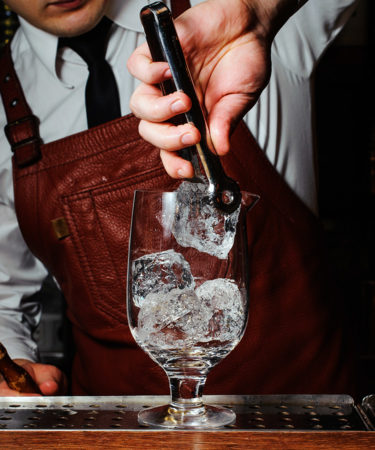On a scale of one to 10, with one being clean and 10 gross, bartenders touching ice barehanded is rarely a nine. Yet the idea of ungloved hands pawing pristine ice is deeply unsettling for some folks on the other side of the bar.
“A Bartender Says There’s a Disgusting Reason to Order Beer or Wine Over Cocktails,” Business Insider warned last fall. (Spoiler: It’s ice!) Fortune published “Why You Should Never Order Drinks With Ice” that same day.
What is it about ice that gets people so up in arms? Bartenders also touch garnishes, straws, and currency, after all.
To unpack this issue, we turned to the experts.
ServSafe, the food and beverage safety program run by the National Restaurant Association, explicitly forbids bartenders from touching ice. “NEVER scoop ice with your bare hands or a glass,” its training manual reads, “Use ice scoops or tongs.”
Beth Demmon, a food and drinks writer and VinePair contributor, agrees. “I am of the opinion that no hand should ever touch ice, bartender or no,” she writes in a message. “Eww!”
Still, every operation has to negotiate compromises between idealism and practicality. People tending busy bars on Saturday nights in Manhattan — not to mention Sundays in October in Green Bay, Wis. — simply want to get drinks to customers as quickly as possible. When every bartender in the establishment has a line of patrons four deep, they can’t be plucking individual cubes of ice with tongs.
Alternatives might include picking up ice using “a cloth or a glove,” Clair McLafferty Evans, a bartender in Birmingham, Ala., and author of “The Classic & Craft Cocktail Recipe Book,” says. These tools are especially useful for the sort of large, spherical or square-shaped ice cubes you might find in an Old Fashioned at a fancy steakhouse.
Neither is foolproof, though. If gloves are rarely changed, or if the same cloth was used to wipe down the bar after a bunch of drunk people shared moules frites, they might be germier than recently washed hands.
“Trust me, there are far grosser things that happen behind the bar than touching ice,” Ellie Bufkin, sommelier, writer, and realist, says. “I think it’s a lesser crime to handle the ice than to risk breaking glass near open containers.”
Dipping empty glassware into an ice container to fill it is both unsanitary and unsafe. Broken glass can easily go unnoticed among glittering ice cubes.
Hope Ewing, author of a forthcoming book on women in the drinks industry, says that, in an ideal world, no one would touch things like ice or garnishes with their bare hands. “But in reality … I find it much more realistic to follow the ‘Regarding Cocktails’ dictum that a bartender thinks of their hands as immaculate tools for making drinks, which of course precludes touching the face, hair, or person, not handling cash, and frequent washing,” she says.
“We are constantly touching ice with our hands,” Brit McMahan, a principal bartender at Drink in Boston, writes in a message. “I feel like if the bar or bartender is consistently practicing good hand-washing, I don’t see why it wouldn’t be O.K.”
In other words, this issue is better addressed with common sense than regulations. If a bartender is stroking a beard or fixing a ponytail and then immediately distributing ice barehanded, consider ordering a canned or bottled beverage. If the staff is washing hands before squeezing garnishes or grabbing ice, though, you’re in a safe space.
(Though not necessarily a ServSafe place.)
